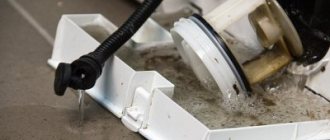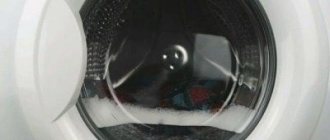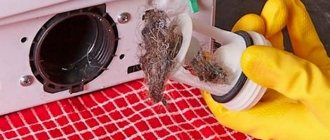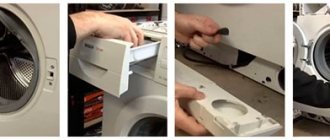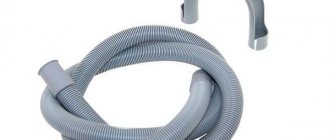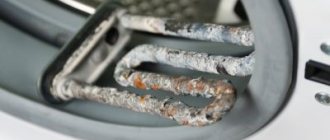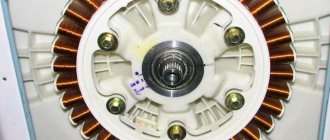The design of automatic washing machines includes elements such as drain and fill filters. They protect equipment from dirt and damage. In order for the filters to perform their functions, they are periodically cleaned.
Manufacturers recommend doing this once every six months. Once you figure out how to clean the filter in your washing machine, you can do it yourself, without professional support. Agree, such skills will save the family budget and allow you to solve the problem quickly, without waiting for the technician to arrive.
But before you start work, you need to study all the nuances of the process. We will tell you what causes the filter to quickly clog and how to understand that it is time to clean it. In addition, we will provide step-by-step instructions for removing contamination, and also list ways to prevent clogging of the filter device.
Signs that cleaning is needed
It is necessary to immediately begin cleaning the system if the following problems are observed:
- The laundry rinsing function has stopped working;
- when you try to put the machine on spin, it turns off or is blocked;
- The water drain does not work well or is completely turned off;
- a puddle of water appeared under the machine;
- the unit has completely failed, this happens rarely, more often when the filter is clogged with large debris.
In the instructions or documents for the washing machine, the drain filter may also be called drainage or garbage.
System health check
After cleaning the Electrolux filter, you need to test the operation of the device to make sure there are no leaks.
To do this you need:
- Open the water supply tap.
- Insert the plug into the socket.
- Set a short operating cycle, monitoring the behavior of the washing machine for leaks.
- If trickles of water appear from under the panel, it is necessary to reinstall it.
When performing a test run after cleaning, do not leave the washing machine unattended. This is necessary so that in the event of a leak, you can quickly respond to the situation.
Where is?
Its location depends on the brand of washing machine. Below is a list with the most popular brands and locations of the required part.
| Electrolux and Zanussi top loading | Washing machine drum rib. Removable from the inside. |
| Atlant | Bottom right corner, hidden behind a small hatch |
| Top-loading machines (except Electrolux and Zanussi) | The lower left corner is usually behind the plastic panel |
| Samsung | Lower right corner, usually hidden behind a plastic panel, but there may also be a small hatch |
| Classic washing machines Electrolux and Zanussi | Lower right corner, covered with a plastic false panel |
| Bosch and Siemens | Lower right corner, covered with a plastic false panel or small hatch |
| Candy | Lower left corner, hidden behind a metal hatch |
| LG | Lower left corner behind plastic or metal hatch |
| Indesit | Behind the lower removable panel on the right |
| Ariston | Behind the lower removable panel on the right or behind the plastic hatch |
How to check if the water drain filter in a washing machine is clogged: signs
Differences between contaminated household appliances:
- Bad aroma. When particles of tissue and dirt accumulate in one place, it turns into a breeding ground for infection. Fungi form here and mold begins to appear. Therefore, a very unpleasant, putrid odor can emanate from the drum itself, as well as from freshly washed clothes.
- The liquid leaves very slowly. The drainage is blocked due to a blockage. With each new wash, the stream will decrease. In this case, the pump actively works almost empty.
- Pumping equipment pumps with malfunctions and roars. Extra noise appeared. This happens when metal or plastic elements (coins, buttons) get into the pump, get stuck there or break some of the impeller blades.
Stages of work
Before directly cleaning the filter, preparatory work is required. It is especially important to pay attention to this point for residents of apartment buildings, since there is a risk of flooding of neighbors.
- First you need to prepare a deep container for draining water and a well-absorbing rag. They cover the washing machine with it, some of the rags are placed under the bottom of the unit. Even after completely draining the water from the drum, a small amount of water remains inside; placing a rag will protect it from flooding.
- Disconnect the drain hose and drain the water from the washing machine through it. This can also be done by loosening the connection between the drain filter and the pump system. Some models have built-in emergency hoses, in which case the water is drained through them.
- Only after this is it possible to unscrew the seat cover. The filter is carefully removed from the system; it is recommended to ensure that it comes out freely and does not catch anything. Sometimes large debris prevents the part from coming out, in which case these fractions should first be moved with objects of suitable size: a screwdriver, knife or tweezers.
- After removing the filter, it is cleaned using any chosen method; the place where the part is installed must be cleaned. Additionally, it is recommended to carry out work to remove limescale, protect against mold and unpleasant odors.
- At the end, the filter is carefully installed in place. It is important to secure it and the protective cover tightly to avoid leaks during operation of the equipment.
Expert opinion
Torsunov Pavel Maksimovich
Before you begin any manipulations with the washing machine, you must completely disconnect it. Even when the power is turned off, there are nodes that can give an electric shock even if you touch them minimally.
To check if this element is clogged, proceed as follows:
- Unplug the machine and drain the water.
- Remove the cap - pull it towards you and set it aside.
- Find the filter cover, it is usually round.
- Place a container into which the remaining water will be drained.
- Unscrew the cap by moving counterclockwise.
- If the filter is dirty, remove foreign objects from the hole and wash the filter element.
- Reassemble the structure in reverse order.
Now you can connect the device to the network and check that it is working correctly.
Cleaning the shot
After removing the drain filter, it is recommended to first rinse it under running water. If there are buttons, pieces of fabric, paper or other debris inside, it must be removed.
Since there will be a large amount of soap and limescale on the part, it needs to be removed; ordinary water will not cope with this. To do this, take a good sponge with an abrasive layer. For better cleaning, the sponge can be soaked in any anti-scale agent; a solution for cleaning a bathroom or toilet is suitable. After washing the filter, rinse it again with warm water.
After this, be sure to check the drain pump where the filter was located. To do this, just shine a flashlight inside and, if necessary, remove any debris in the system. After this, the part is put in place, secured, and the machine is turned on to check for leaks.
Although experts recommend cleaning the drain filter every few months, when washing duvets, pillows and similar items, it is better to open the drain system immediately after washing and clean it. There will definitely be a large amount of fluff, wool and feathers inside.
Reasons for clogged filters
The main factors of contamination of filter systems are:
- rust and its detachments. The filter rusts due to constant contact with tap water. It is required to check its condition once every 3 months - so the permeability and quality of water inflow will remain unchanged;
- lime deposits. When the filter and waste water come into contact, evaporated salts and minerals settle on the part;
- small elements. During washing, wool, hair, fasteners, sand and debris are washed out of clothes. Timely removal of the blockage will prevent clogging of the filter and ensure that the machine can drain the filter.
Important! In hard water, lime deposits form on the filter faster.
Cleaning without removal
If you do not want to remove the part from the system, you can try cleaning it without removing it. This can be done in several ways.
Are you cleaning your washing machine drain filter?
Of course! Rarely, but it happens
Lemon acid
To clean the filter using this substance, you will need:
- Open the container for the powder and pour 50-100 g of citric acid into it; the greater the likelihood of contamination, the more substance we add.
- Having closed the container, select a mode with a minimum temperature of 60 degrees, with heavy contamination - 90 degrees.
- After completing the cycle, put the washing machine on a rinse cycle to remove any remaining citric acid.
- If after one cycle it was not possible to remove all the debris, repeat the cleaning until it is completely clean, this will be visible by the transparency of the water inside the washing drum.
Table soda
This substance allows you to clean not only debris, but also remove mold that forms not only on the filter, but also inside the hoses.
To clean, you will need to do the following:
- 50 g of soda should be poured inside the washing drum and into the container for washing powder; you can combine the substance in equal proportions with the powder, so the result will be better;
- turn on the maximum temperature mode and wash for at least 2 hours;
- after completing the cycle, you should wipe all open parts of the washing machine, including the powder container;
- In case of heavy contamination, the procedure should be repeated one more time.
Table vinegar
When using the substance, protect your eyes and respiratory system. For cleaning, vinegar with a 9% concentration is used.
- To clean the drain filter of the entire washing machine system, 200-250 ml of vinegar must be poured into the washing powder tray.
- We turn on the washing mode at 60-90 degrees, which lasts at least 2 hours, but not manually.
- After one hour of washing, turn off the machine and leave it for 1-2 hours to settle. After this, the washing machine starts again.
- If necessary, several cleaning cycles are carried out.
After using vinegar, it is recommended to remove the filter in any case. Acetic acid perfectly removes dirt from inside the system, so there is a high risk that the filter will become even more dirty if a lot of debris has accumulated inside the machine itself. After that, it is recommended to turn on the machine again with a small portion of powder, soda, vinegar or citric acid.
Bleach or any product containing high chlorine
When working with such substances, you should be as careful as possible, avoiding contact with eyes, respiratory organs and skin.
- Pour 20-50 ml of white into the tray for washing powder and turn on the mode with maximum temperature.
- After 15 minutes of operation of the washing machine, pause and leave everything for 1-2 hours.
- After this time, we restart the system for 40-60 minutes. After completing the cycle, add a little of any suitable cleaning agent to the powder container and run the machine at 1-1.5 to eliminate the pungent odor of chlorine.
These methods are more preventative, as they do not allow large debris to be removed. They are recommended to be combined with the main one to achieve ideal cleansing of the entire system.
Why do you need cleaning equipment?
The main task is to filter the incoming liquid and subsequently purify the waste liquid after the washing process. In the first case, this is justified, since even a chlorinated water supply is not always perfectly clean, and even more so if it is extracted from a well. To prevent the mesh from becoming clogged very quickly, we recommend that owners of private water intake points install a high-quality filtration system from.
The second device is necessary to prevent the pump from breaking. It filters lint, pieces of clothing, threads and large insoluble dirt. Of course, water treatment is crude; reusing the liquid is strictly prohibited.
Questions and answers
Does the number of times you clean the drain filter depend on the brand of washing machine?
No. But the older the device, the more often you will need to care for it.
How often should you clean the drain filter in your washing machine?
Such work must be carried out every six months. If the washing machine is used several times a week, cleaning is carried out every three months.
Will citric acid harm the drain system?
No, it is even used in dishwashers. The main thing is to choose the appropriate temperature regime.
Isn’t it better to turn to a specialist for such work?
This amount of work is quite within the capabilities of any person, so it makes sense to call for repairs only if for some reason you cannot remove the filter or its cover.
Is it possible to use several substances at once when cleaning on one day, but in different cycles?
Of course you can. But strictly in different cycles, so as not to provoke the release of toxic fumes into the air.
Preventing the problem from recurring
To ensure that the filter cover does not become sour and can be easily unscrewed, it is necessary to periodically open it and clean the filter from the very beginning of operation (as prescribed in the instructions).
When screwing, you need to make sure that the lid is not skewed and fits exactly along the thread.
Some craftsmen use a special plumbing paste such as Unipak or similar. It fills the threads and prevents dirt from penetrating between the threads.
At the same time, the paste itself is not aggressive towards plastic, does not decompose or dissolve it. This protection of the lid allows you to open it without difficulty the next time.
